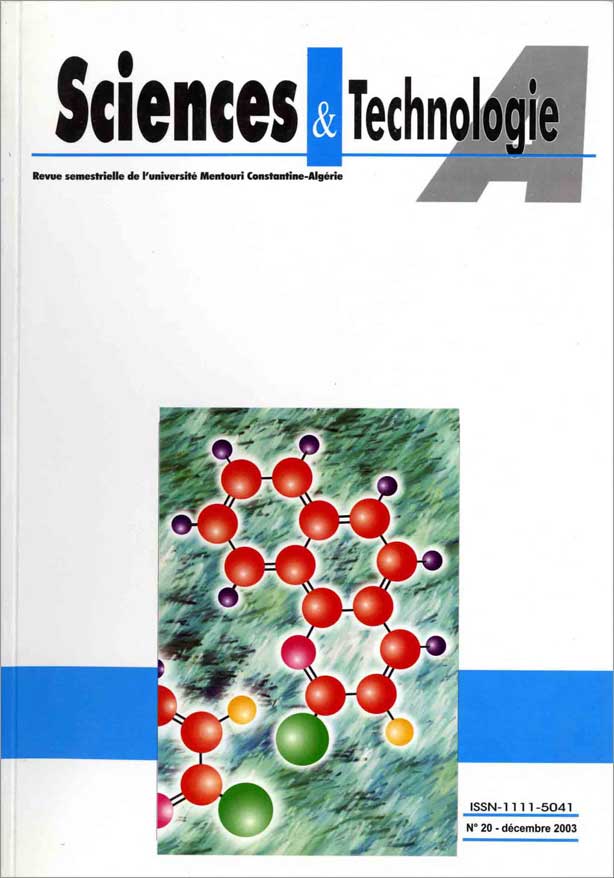STUDY OF A SILICON POWER DIODE USING A TIME DEPENDENT HYDRODYNAMIC MODEL
Keywords:
Hydrodynamic, power diode, transient, carrier temperature, degradationAbstract
A one-dimensional device simulator based on the hydrodynamic model is developed for the simulation and analysis of high voltage ambipolar devices. This simulator has the capability for both self-consistent transient and steady state regime study. The discretization scheme used in the algorithm shows good numerical stability and accuracy.
A transient simulation study is carried out on a PIN diode. Information about electrical potential, electron and holes concentration, carriers temperatures, average velocities, considering the transient response to a high voltage, shows this simulator quite a good tool to study power devices in futures trends. While no significant differences appear between our results and drift diffusion model ones, for the quiescent state, it is not the case for the transient regime. Moreover, our model does not handle some strong simplification hypothesis; for instance it is pointed out that carrier explicit acceleration term can not be dodged so easily, as reported before, for an accurate transient study.
Downloads
References
- Baliga B.J., "Modern Power Devices Wiley Interscience", New York, (1987).
- Latreche S., "Etude de transistors bipolaires à émetteur polysilicium auto-aligné réalisés en technologie CMOS", Doctorat d’état, Université de Constantine, Oct. (1998).
- Grasser T., Ting-Wei Tang H., Selberherr S., "A review of hydrodynamic and energy-transport models for semiconductor device simulation", Proceedings of IEEE, Vol. 91, N°2, (2003), pp.251-274.
- Hamza M., Morel H. and Chante J.P., "A novel consistent discretization scheme for the integrated HDM/DDM simulation of semiconductor devices", Advances in mathematics and techniques, Glowenski ed., New York : Nova Science Publishers Inc., (1991), p.759-768.
- Souissi K., Odeh F., Tang H.H.K., Gnudi A., Lu P.-F., "Investigation of the Impact Ionisation in the Hydrodynamic Model", IEEE trans. on Elec. Dev., Vol.40, N°8, (1997), pp.1501-1507.
- Hamza M., "Modélisation hydrodynamique des phénomènes de transport de porteurs chauds et de l'ionisation par impact dans les dispositifs à semi-conducteurs", Thèse de Doctorat, INSA de Lyon, (1993).
- Baohong Cheng Rao V.R., Woo J.C.S., "Exploration of velocity overshoot in Semiconductor", IEEE trans. on Elec. Dev., Vol.20, N°10, (1999), pp.538-540.
- Schroedre D., "Modelling of interface carrier transport for device simulation", Edited by S. Selberherr, Computational Microelectronics, (1994), p. 217.
- Jungemann C., Meinerzhagen B., "On the applicability of nonself-consistent Monte Carlo device simulations", IEEE trans. on Elec. Dev., Vol.49, N°6, (2002), pp.1072-1074.
- Baccarani G. and Wordmann M., "An Investigation of The Steady-State Velocity Overshoot in Silicon", Solid State Electronics, Vol.28, N°4, (1985), pp.407-416.
- Seeger K., "Semiconductor Physics", Ed. Springer (2002).
- Engl W. and Dorks H.K., "Models of Physical parameters", In: An Introduction to the Numerical Analysis of Semiconductor Devices and Integrated Circuits, Dublin, Boole Press, (1981), pp.223-228.
- Dorkel J.M. and Leturcq P., "Carrier Mobilities in Silicon Semi-Empirically Related to Temperature, Doping and Injection Level", Solid State Electronics, Vol.24, N°9, (1981), pp.821-825.
- Canali C., Maijni G., Minder R. and Ottaviani G., "Electron and Hole Drift Velocity Measurements in Silicon and their Empirical Relation to Electron Field and Temperature", IEEE Trans. Electron Devices, Vol. ED-22, (1975), pp.1045-1047.
- MEDICI: TMA-MEDICI, two-dimensional Device Simulation Program, Technology. User’s Manual, (2000).







